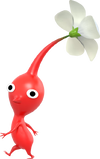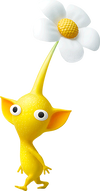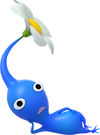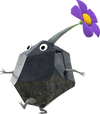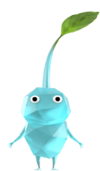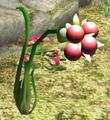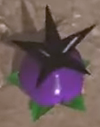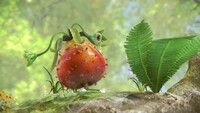User:Dolphinius/SpecBio: Difference between revisions
Dolphinius (talk | contribs) No edit summary |
Dolphinius (talk | contribs) (Citations and images) |
||
| Line 19: | Line 19: | ||
====Red Pikmin==== | ====Red Pikmin==== | ||
[[File: Pikmin 4 Red Pikmin Walking.png|left|100px|A Red Pikmin]] | [[File: Pikmin 4 Red Pikmin Walking.png|thumb|left|100px|A Red Pikmin.]] | ||
{{clear}} | {{clear}} | ||
====Yellow Pikmin==== | ====Yellow Pikmin==== | ||
[[File: Yellow Pikmin artwork P3.png|left|100px|A Yellow Pikmin]] | [[File:Yellow Pikmin artwork P3.png|thumb|left|100px|A Yellow Pikmin.]] | ||
They also have a strange fascination with bomb rocks. | They also have a strange fascination with bomb rocks {{cite quote|The yellow Pikmin have picked up some peculiar stones. Why did they decide to grab them? This action seems to be instinctive to the yellow Pikmin.|Captain Olimar|his initial notes on the [[Yellow Pikmin]]}}, more so than other Pikmin species. | ||
[[File: Yellow Pikmin holds bomb rock P1 art.png|thumb|130px|A Yellow Pikmin holding a bomb rock]] | [[File:Yellow Pikmin holds bomb rock P1 art.png|thumb|130px|A Yellow Pikmin holding a bomb rock]] | ||
{{clear}} | {{clear}} | ||
====Blue Pikmin==== | ====Blue Pikmin==== | ||
[[File:Pikmin 4 Blue Pikmin Posing.png|thumb|left|100px|A Blue Pikmin.]] | |||
{{clear}} | |||
====Purple Pikmin==== | |||
[[File:P4 Purple Pikmin Render.png|thumb|left|80px|A Purple Pikmin.]] | |||
{{clear}} | |||
====White Pikmin==== | |||
[[File:White pikmin 3.png|thumb|left|80px|A White Pikmin.]] | |||
{{clear}} | |||
====Winged Pikmin==== | |||
[[File:Pikmin 4 Winged Pikmin.png|thumb|left|80px|A Winged Pikmin.]] | |||
{{clear}} | |||
===Hermikmin=== | ===Hermikmin=== | ||
{{cite quote|The stone is actually the chosen host for a parasitic subset of Pikmin species nicknamed "Hermikmin."|Captain Olimar|his log on [[Rock Pikmin]], a type of Hermikmin.}} | |||
{{clear}} | |||
====Rock Pikmin==== | ====Rock Pikmin==== | ||
[[File:P4 Rock Flower Pikmin Walk.png|thumb|left|100px|A Rock Pikmin.]] | |||
{{clear}} | |||
====Ice Pikmin==== | ====Ice Pikmin==== | ||
[[File:P4 Leaf Ice Pikmin Artwork.png|thumb|left|100px|A Winged Pikmin.]] | |||
{{cite quote|Pikmin supposedly evolved from plants, yet there are also Pikmin species with bodies made of ice, known as ice Pikmin. How is this possible? The answer to this question lies in the fact that Ice Pikmin are parasitic by nature, and the ice serves as their host|Captain Olimar|his log on [[Ice Pikmin]]}} | |||
{{clear}} | |||
====Bulbmin==== | ====Bulbmin==== | ||
[[File:Bulbmin.png|thumb|left|100px|A Bulbmin residing within its bulborb host.]] | |||
Symbiotic | |||
{{clear}} | |||
==Pellet Weeds== | ==Pellet Weeds== | ||
| Line 68: | Line 110: | ||
''Pikanthus expellus'' | ''Pikanthus expellus'' | ||
[[File: Crimson Candypop Bud P2S icon.png|thumb|left| | [[File:Crimson Candypop Bud P2S icon.png|thumb|left|80px|Crimson variety (''P. e. rufusia'')]] | ||
[[File: Violet Candypop Bud P2S icon.png|thumb| | [[File:Violet Candypop Bud P2S icon.png|thumb|80px|Violet variety (''P. e. puniceus'')]] | ||
[[File: Golden Candypop Bud P2S icon.png|thumb|left| | [[File:Golden Candypop Bud P2S icon.png|thumb|left|80px|Golden variety (''P. e. aurumia'')]] | ||
[[File: Ivory Candypop Bud P2S icon.png|thumb| | [[File:Ivory Candypop Bud P2S icon.png|thumb|80px|Ivory variety (''P. e. niveus'')]] | ||
[[File: Lapis Lazuli Candypop Bud P2S icon.png|thumb|left| | [[File:Lapis Lazuli Candypop Bud P2S icon.png|thumb|left|80px|Lapis Lazuli variety (''P. e. cobaltum'')]] | ||
[[File: Gray Candypop Bud.png|thumb| | [[File:Gray Candypop Bud.png|thumb|80px|Smokey variety (''P. e. lithosia'')]] | ||
[[File: Pink Candypop Bud.png|thumb| | [[File:Pink Candypop Bud.png|thumb|80px|Rose variety (''P. e. rosa'')]] | ||
These flowers | These flowers | ||
| Line 89: | Line 131: | ||
====Candytrap Bud==== | ====Candytrap Bud==== | ||
''Malanthus dichroma'' | ''Malanthus dichroma'' | ||
[[File: NamaPongashi closed.png|thumb|left|100px|Dormant | [[File:NamaPongashi closed.png|thumb|left|100px|Dormant candytrap]] | ||
[[File: NamaPongashi open.png|thumb|left|100px|Active | [[File:NamaPongashi open.png||thumb|left|100px|Active candytrap]] | ||
Candytraps are a primitive species of candypop, and are one of the last remaining species that have retained their insectivorous diet. As such, any Pikmin tossed into its interior will be consequently devoured. | Candytraps are a primitive species of candypop, and are one of the last remaining species that have retained their insectivorous diet. As such, any Pikmin tossed into its interior will be consequently devoured. | ||
It lures its prey with its bright colours and unusually sweet scent. Its coated in an extremely adhesive material, making any caught unable to escape. Once entrapped, it devours its prey with an acidic substance that quickly dissolves most biological tissues. | It lures its prey with its bright colours and unusually sweet scent. Its coated in an extremely adhesive material, making any caught unable to escape. Once entrapped, it devours its prey with an acidic substance that quickly dissolves most biological tissues. | ||
| Line 102: | Line 144: | ||
====Quaggled Mireclops==== | ====Quaggled Mireclops==== | ||
[[File:Quaggled_mireclops.png|thumb|left|100px|A quaggled mireclops]] | |||
{{clear}} | |||
====Mireclops Bulb==== | ====Mireclops Bulb==== | ||
[[File:P3D Quaggled Mireclops Head.jpg|thumb|The parasite atop a quaggled mireclops.]] | |||
[[File:Mireclops eye.jpeg|150px|thumb|An eye of a mireclops bulb]] | |||
Surprisingly, the bulbous head upon the encountered mireclops is actually an entirely separate organism. {{cite quote|Some theorize that the fruit-like growth atop its main body is in itself a parasitic species living off the nutrients it drains from the mireclops's enormous body.|Captain Olimar|his log on the [[Quaggled Mireclops]]}} | |||
{{clear}} | {{clear}} | ||
==Ambulofungi== | ==Ambulofungi== | ||
The Ambulofungi are another separate clade that have evolved animalistic traits, such muscle fibres and nervous systems. The most well-known group of these fungal-animals are the Sporovids. | The Ambulofungi are another separate clade that have evolved animalistic traits, such muscle fibres and nervous systems. The most well-known group of these fungal-animals are the Sporovids.{{cite quote|A type of Ambulofungus, the current working theory is that the Puffstool evolved from a more common species of fungus that gained animal-like characteristics over time, including the ability to walk.|Captain Olimar|his log on the [[Puffstool]]}} | ||
Akin to the Ambuloradicis, the Ambulofungi group has an elusive ancestory and origins. | Akin to the Ambuloradicis, the Ambulofungi group has an elusive ancestory and origins. | ||
| Line 127: | Line 172: | ||
====Toxstool==== | ====Toxstool==== | ||
[[File:Toxstool P4 icon.png|thumb|left|100px|A toxstool.]] | |||
{{clear}} | |||
==References== | |||
{{refs}} | |||
Revision as of 11:30, July 10, 2024
This sub-page is purely speculative. It builds upon established information from the Piklopedia, but is altered to be slightly more accurate in terms of biology, evolution and taxonomy. It still may not be entirely accurate, as Pikmin entries are very strange and vague to work with, but I am aiming for at least potential plausibilty. If there were to be an article on Ambuloradicis (its too small of a subject to warrant its own article really), then it would a whole lot less speculative and more formal.
Ambuloradicis
A class of plants that developed animalistic traits, such as nervous systems and muscle tissues. How or why a group of plants evolved such amazing traits is unknown, though its suspected to be a result of experimentation from the long lost civilisation that once lived here. Its common ancestor is, unfortunately, a mystery.
The singular noun of Ambuloradicis is ambuloradix.
WIP
Pikmin
The most well-known Ambuloradicis are the Pikmin, a diverse family that have developed a humanoid physique. Its success comes from its advanced nervous system and a larger, more concetrated neurological organs that allow it to perform more complex tasks. They have develoed higher cognitive functions, and work as a colony to help propogate their species. Thanks to the Pikmins curiosity, drive to explore, symbiotic relationships and adaptive speciation, the Pikmin family has reached near cosmopolitan status.
Red Pikmin
Yellow Pikmin
They also have a strange fascination with bomb rocks [1], more so than other Pikmin species.
Blue Pikmin
Purple Pikmin
White Pikmin
Winged Pikmin
Hermikmin
Rock Pikmin
Ice Pikmin
Bulbmin
Symbiotic
Pellet Weeds
Burgeoning Spiderwort
Pellet Posy
Onions
Onion
Flarlic
Candypop Buds
Common Candypop Bud
Pikanthus expellus
These flowers
Queen Candypop Bud
Pikanthus regina
Candytrap Bud
Malanthus dichroma
Candytraps are a primitive species of candypop, and are one of the last remaining species that have retained their insectivorous diet. As such, any Pikmin tossed into its interior will be consequently devoured. It lures its prey with its bright colours and unusually sweet scent. Its coated in an extremely adhesive material, making any caught unable to escape. Once entrapped, it devours its prey with an acidic substance that quickly dissolves most biological tissues.
Chrysanthoids(?)
Chrysanthemum family, but under a different name.
Mireclops
Quaggled Mireclops
Mireclops Bulb
Surprisingly, the bulbous head upon the encountered mireclops is actually an entirely separate organism. [4]
Ambulofungi
The Ambulofungi are another separate clade that have evolved animalistic traits, such muscle fibres and nervous systems. The most well-known group of these fungal-animals are the Sporovids.[5]
Akin to the Ambuloradicis, the Ambulofungi group has an elusive ancestory and origins.
Startle Spore
Whilst similar in appearance to the Chrysanthoids, this is actually due to convergent evolution rather than a related ancestry. As they require similar hosts, they often come into direct competition if there territories overlap.
Sporovids
Puffstalk
Puffstool
Toxstool
References
- ^ “The yellow Pikmin have picked up some peculiar stones. Why did they decide to grab them? This action seems to be instinctive to the yellow Pikmin.” – Captain Olimar in his initial notes on the Yellow Pikmin
- ^ “The stone is actually the chosen host for a parasitic subset of Pikmin species nicknamed "Hermikmin."” – Captain Olimar in his log on Rock Pikmin, a type of Hermikmin.
- ^ “Pikmin supposedly evolved from plants, yet there are also Pikmin species with bodies made of ice, known as ice Pikmin. How is this possible? The answer to this question lies in the fact that Ice Pikmin are parasitic by nature, and the ice serves as their host” – Captain Olimar in his log on Ice Pikmin
- ^ “Some theorize that the fruit-like growth atop its main body is in itself a parasitic species living off the nutrients it drains from the mireclops's enormous body.” – Captain Olimar in his log on the Quaggled Mireclops
- ^ “A type of Ambulofungus, the current working theory is that the Puffstool evolved from a more common species of fungus that gained animal-like characteristics over time, including the ability to walk.” – Captain Olimar in his log on the Puffstool

